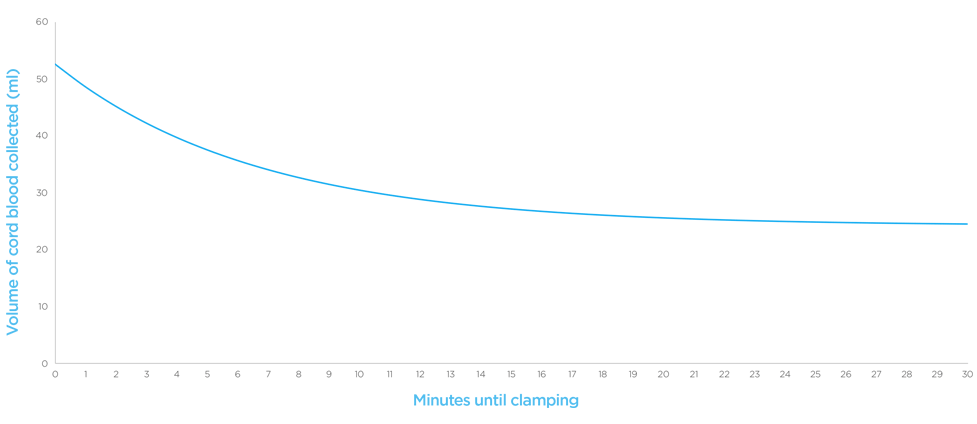Delayed & Optimal
Cord Clamping
When you choose Cells4Life
Delayed & Optimal Cord Clamping
100% compatible with cord blood banking – when you choose Cells4Life
Cord blood banking is fully compatible with delayed cord clamping and optimal cord clamping with our CellsPlus service, powered by TotiCyte.
Delayed cord clamping and particularly optimal cord clamping both have an impact on the amount of blood available for cord blood collection. After optimal cord clamping, depending on the processing method used, samples may be too small for processing or contain too few cells for therapeutic use.
With Cells4Life’s CellsPlus method, we can still process smaller volumes of blood, and deliver 2 to 3 times more stem cells at the point of treatment, meaning that small volumes processed using CellsPlus could be just as useful as larger samples processed using another method*.
3x more stem cells when you choose CellsPlus
Our exclusive CellsPlus service, powered by our TotiCyte cord blood processing technology, preserves two to three times more stem cells at the point of treatment than other industry leading systems available today.*
What are delayed cord clamping and optimal cord clamping?
Delayed cord clamping is recommended by the National Institute for Health and Care Excellence (NICE) and increasing awareness means that more and more parents are turning to delayed or optimal cord clamping to give their baby the best possible start to life. Delayed cord clamping is where the umbilical cord is not clamped for one to two minutes and optimal cord clamping is where clamping is delayed for as long as it takes for the cord to stop pulsating and turn white.
Why choose optimal or delayed cord clamping?
Immediate cord clamping has been shown to reduce baby’s blood supply by up to 34% and their red blood cells by up to 50%.[1][2][3] Literature indicates that postponing clamping for at least 30 seconds reduces mortality in full and, particularly pre-term babies, by 32%.
Despite this, 40% of UK births use immediate cord clamping and many babies still miss out on vital extra blood.
Are optimal or delayed cord clamping compatible with cord blood banking?
Delayed, and especially optimal, cord clamping usually mean that there is less blood in the umbilical cord for collection. Even if blood remains, it may have clotted.
In the case of optimal cord clamping, it is often only possible to collect as little as 10 to 20 millilitres of blood residual in the placenta. Most cord blood processing methods require at least 40ml of blood.
The CellsPlus Difference
Our CellsPlus service is the most popular processing system in the UK. It gives you the freedom to choose to both protect your child at birth with delayed or optimal cord clamping and in the future, by saving their cord blood stem cells. CellsPlus is based on TotiCyte, our patented processing technology, which can be successfully applied to small cord blood samples to deliver between 2.2 and 3 times more stem cells at the point of treatment than other cord blood processing systems.[5]
Birth is a biological process, so there are never any guarantees, but choosing CellsPlus means you and your family shouldn’t have to compromise. You can choose delayed or optimal cord clamping and expect to still be able to bank baby’s stem cells.
Cord tissue banking
Umbilical cord tissue stem cell collection is 100% compatible with every birth choice. All that is required is an undamaged section of the umbilical cord itself, which is cut and placed into saline after birth. Delayed and optimal cord clamping have no impact on this procedure, so even in the unlikely event that we don’t collect enough blood, it is pretty much always possible to store cord tissue, and you will only have to pay for this element of the service. Umbilical cord tissue stem cells may be even more powerful than cord blood for regenerative therapies, so cord tissue collection is by no means a second best.
Learn more about the uses of umbilical cord tissue.
Supported by midwives

MaMa Conference
We sponsor MaMa Conference, which is the largest midwifery conference in the UK.
“TotiCyte has transformed stem cell retention both during the processing procedure and in cryopreservation and it is the highest performing cord blood processing system in the world. This could play an important part in promoting optimal cord clamping, providing all of the significant benefits for babies while still meeting the needs of parents who do choose to bank or donate their babies’ stem cells.”
Cass McNamara, midwife and founder of the MaMa Conference
FIND OUT MORE, REQUEST YOUR WELCOME PACK TODAY
Connect with us
*based on our peer reviewed publication showing that TotiCyte delivers 2.2 to 3 times more haematopoietic stem cells at the point of use than other cord blood processing systems in use in the UK.
References
[1] McDonald S. Physiology and management of the third stage of labour. In: Fraser D, Cooper M editor(s). Myles Textbook for Midwives. 14th Edition. Edinburgh: Churchill Livingstone, 2003.
[2] Mercer JS. Current best evidence: a review of the literature on umbilical cord clamping. Journal of Midwifery & Women’s Health 2001;46(6):402‐14.
[3] Mercer JS. Current best evidence: a review of the literature on umbilical cord clamping. In: Wickham S editor(s). Midwifery: Best Practice. Vol. 4, Edinburgh: Elsevier, 2006:114‐29.
[4] Palethorpe RJ, Farrar D, Duley L. Alternative positions for the baby at birth before clamping the umbilical cord. Cochrane Database of Systematic Reviews 2010, Issue 10. [DOI: 10.1002/14651858.CD007555.pub2]
Does Delayed Umbilical Cord Clamping Impact Family Banked Cord Blood? Parents Guide to Cord Blood Banking




